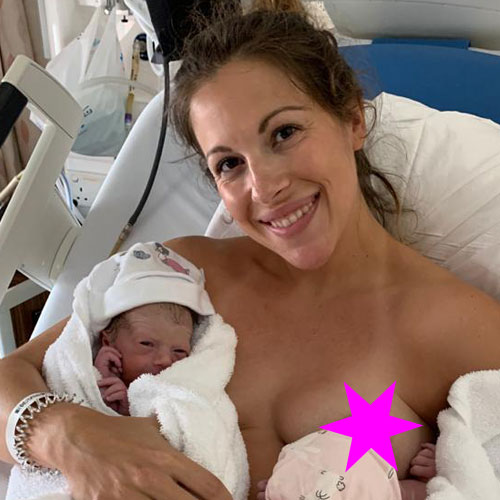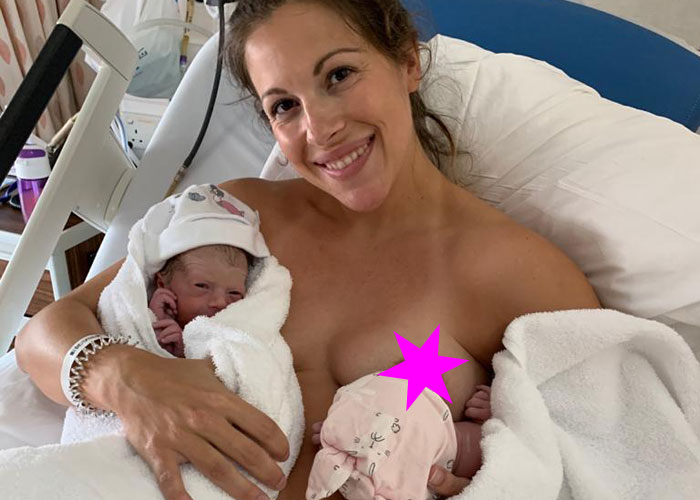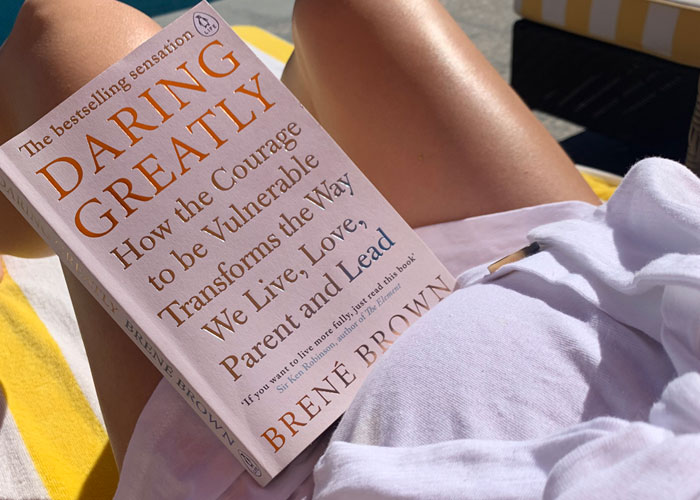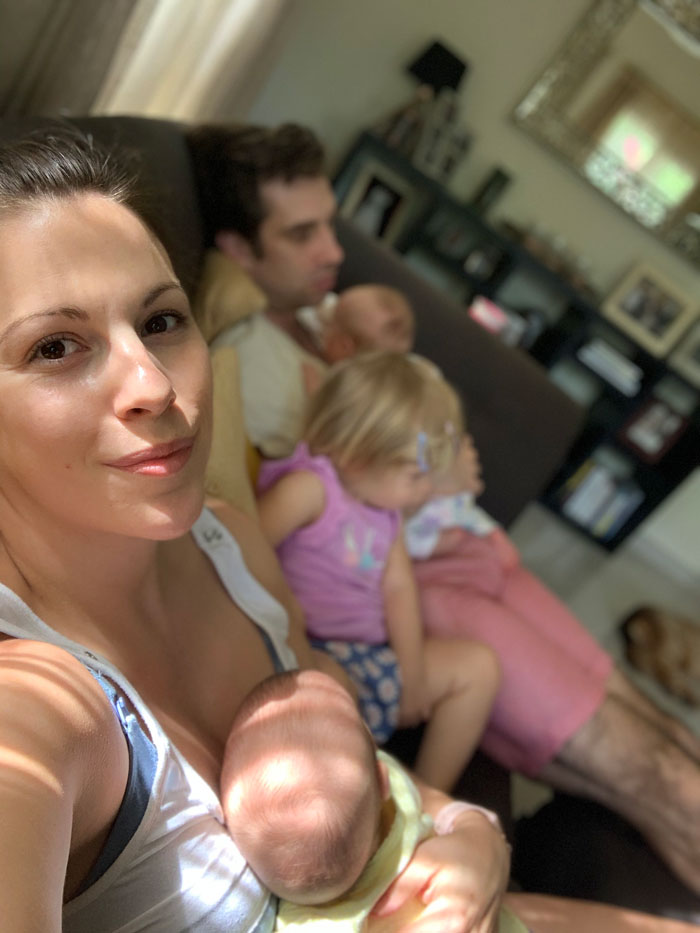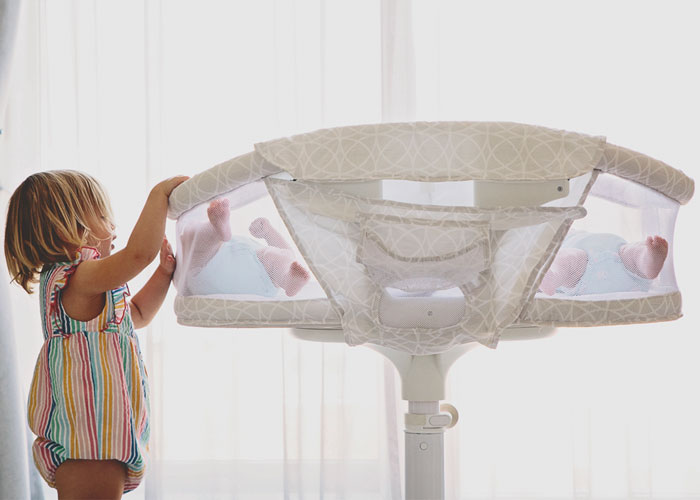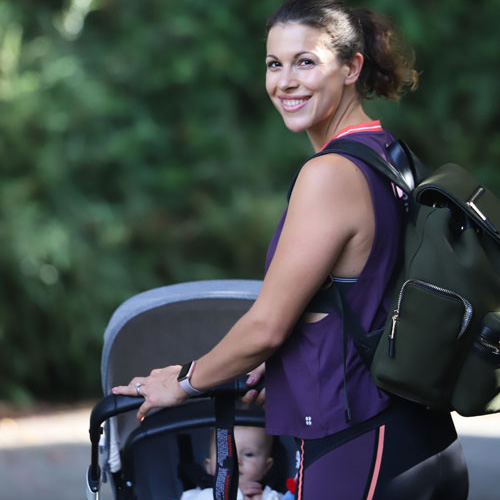Astrid was facing me when I delivered her, lying on my side. I was only vaguely aware of my husband cutting her cord while we spent a few minutes alone, her against my chest, us against the world. Her first cry, like a geyser breaking surface, softened the tension of worry in my chest. There was space now for something else. And someone else, too.
Dylan was ready in waiting, rapid through an open birth canal, as I pulled her to daylight and met her there, face to face. Two ‘back to back’ deliveries carried on a flood of oxytocin. A second tidal wave of love. A river of tears shed in relief. Two warm, healthy babies migrated from my belly to my chest. 35 weeks and 4 days of positive affirmation, sweetly affirmed. They were here. (Full birth story here)
Here we were, beginning a period of tremendous adjustment. Undertaking the fourth trimester with two babies is an altogether remarkable experience, and I hope some of my shared experience will guide and support you in yours.
MIND
Like many new mums of multiples, I had to say goodbye to my new babies nearly as promptly as I’d welcomed them. They spent three nights in NICU to support their low birth weight. Their suck reflux still underdeveloped, I hand-expressed milk (with the support and skill of my wonderful doula Lala Langtry-White!) for the nurses to feed them through syringes.
I took up a quiet, surreal residence in the post-natal ward, a hospital-grade pump whirring like white noise while the cries of new babies and the coos of their mothers punctuated the silence. I listened to my neighbours learning a new language, and it brought me both comfort and pain. This was every bit as contradicting as the sorrow and reassurance I felt by the softly shuffling shoes, beeps and alarms of the NICU. My babies were healthy, they were going to be OK – teeny, tiny as they were, but free of breathing tubes and IVs. I saw them every three hours, and they would come home with me after three nights. We were lucky. But this cycle of feed, pump and clock-watch was only just beginning…
RISING RESILIENCE
Nurses periodically checked on me, too. I recall the shock of uterine contractions far more intense than they’d been with my first – common after twin deliveries, but something for which I wasn’t prepared. I’d wince as my tummy was squished and adjusted to accelerate the eviction. The emptier my uterus, the greater the disconnect I began to feel between me and my babies. Our team of three was divided, them alone in their NICU pods, me a floor above in the post-natal ward.
The shock of separation was overshadowed only by the shock of our reunion, a mere hour before our discharge. Three days had stretched on and on, then like a rubber band it snapped and the reality of handling two premature babies with no medical supervision – and a surreal new March 2020 pandemic world crumbling around us – would become the single most resilience-affirming event of my life.
At home with the twins, everything was new. And everything was challenging. Dylan was an extremely sleepy feeder. So we learned about finger-feeding and my husband helped with top-ups after feeds. Lockdowns kept getting stricter, so we embraced frequent 10-minute walks around the block. The twins increasingly tag-teamed when they slept, so we tried every variation of tandem sling to synchronise their naps. My eldest began to rebel, so we designed 10-minute activities to give her the one-on-one time she desperately needed. Day by day, it got easier. Except that it didn’t. We were just getting more resilient.
VICTORY IN VULNERABILITY
This is a picture of my 30-week twins (inutero) and I catching up on some Brene Brown a few weeks before their delivery. Brene’s insights on vulnerability would prove more relevant than I anticipated. Recognising vulnerability as my ultimate strength was the life-preserver that kept me afloat through my fourth trimester with twins. This wasn’t something that came easily to me, but the exceptional challenges of having two very small twin babies to care for (and a stay-at-home toddler used to running off steam at nursery) made real, honest, ego-abating vulnerability the best healing resource for all of us.
It was my vulnerability that made me hold my hands up and admit I needed help at night. I needed, for at least a few nights a week, the certainty of sleep. We employed a part-time night nurse “for the first month” (which turned into nearly nine!). The nurse would bring the babies in sequence to me for their feeds, and take care of the burping, changes and resettling in between. I’d pump for one night feed, allowing me to sleep for a 3-4 hour stretch.
When the familiar tug-and-pull of mum-guilt kicked in – or that type-A calling to do-it-all – I’d run a mental list of everything I had achieved in a single day managing my tribe of minis. I could either be willingly vulnerable and ask for help when I needed it, or I could drive myself into the ground and become unwillingly vulnerable in the process. In a pandemic era, that picture became even clearer. To accept help was to prioritise health.
BODY
I was always prepared for the likely outcome of a C-section and a slower return to exercise – nearly 60% of twins are born this way in the UK (NHS), and far more in the UAE. The stars aligned beautifully for the vaginal birth I wanted, and I was lucky to begin a return to movement quite soon after delivery.
The physicality of looking after twins – particularly when there are older children involved – is nothing short of a daily workout itself, so a proactive (and gentle) return to exercise is hugely beneficial to facilitating your strength and resilience to everyday movement. This is true independent of how you birthed your twins, so I’ll include some variations of the rehab and strengthening journey I followed so you can tailor it to your own needs and experience.
FIRST STEPS
To counter the sedentary nature of a very strict lockdown, I dusted off an old aerobic step and simply did very basic, low-impact steps up and down. I’d prioritise knee-over-ankle alignment and kept my pinky toe heavy, which helps to maintain or restore the arch in your foot, commonly flattened during pregnancy. This was a great time to work on my breathing and initiate the connection between diaphragm and pelvic floor; exhaling with each step up as I drew up and in with my pelvic floor, inhaling with each step down as I allowed those support muscles to soften. Relax and enjoy your movement (it was my personal sanity check in the early days!) but occasionally bring your mind to your posture and align your ribs with your hips – this is the neutral posture that best recruits your core and supports your spine.
I was ready to start a bit of movement on the mat around 2 weeks postpartum. I’d combine the diaphragm breath with a deeper low-belly connection and practice this in seated, kneeling and all-fours positions. I did do some supine exercises, but was wary of doing all my core work while lying on my back, because it limits how much circumferential tensioning (the corset-like movement of transverse abs drawing in) is possible.
As well as bodyweight connections, I was quick to add a resistance band to classic post-natal exercises like heel slides and leg marches. Holding the theraband with straight arms, I’d gently pull on it during the ‘working’ part of the movement. This would add a bit more load to my core – both a way of progressing the exercise, and a way of helping to isolate the work in the abs.
By six weeks post-natal, I was ready to introduce a light weight to familiar movement patterns I’d been practising with no weight or with only a resistance band. This post from Instagram shares 7 movements that felt beneficial for me during my early postpartum recovery.
My personal post-natal guidelines proved very accurate to my experience this time around: allow 3 months to rehabilitate (establishing excellent whole-body connectivity via the core), 3 months to pre-habilitate (build strength with the intention of preventing injury), and 3 months to rebuild (bringing your strength back on par with your pre-pregnancy or early pre-natal levels).
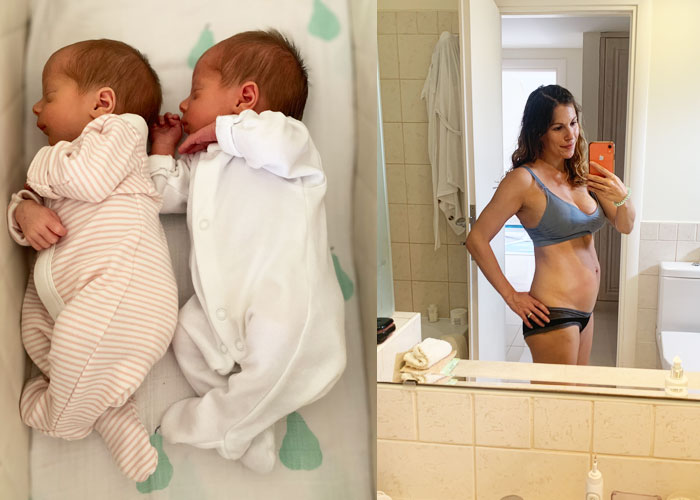
SENSE CHECKS
Due to the pandemic, and the craziness of our schedule at home with 3 children under 3, I didn’t get around to my post-natal physio check-up until nearly 9 months post-natal. On many levels, I was as strong as I had been pre-pregnancy, but I was lacking the intimate knowledge of my internal support muscles that only a pelvic health physio can ascertain. So away I went to the much-recommended Optimal Fitness physio team, where I learned that my pelvic floor was in good shape bar a potential expulsion of one of the muscles (which hadn’t affected my capabilities whatsoever), and that my core was functioning well.
However, what drove me to finally book in was an acute and sudden flare up of lower back pain. My take-away learnings were important, so listen up. I was given full permission to load my core and to FLEX my spine in order to progress my fitness and optimise the mobility of my spine – which was currently ‘stuck’ along the length of my lumbar. I was about to embark on Munira Hudani’s Diastasis Recti course, which would address some of my pre-held beliefs about minimising flexion when working with a diastasis and redirect the emphasis to effective tensioning around the lines alba. The timing couldn’t have been better, because the absence of flexion in my spine was the very thing causing the lower back pain I’d been trying to avoid. My remaining diastasis was minimal, but even if it was bigger, I could produce strong and consistent tension in my midline to support abdominal flexion. And it was this very abdominal flexion – starting with very gentle spinal rolls to ease up my stiff lumbar spine, progressing to crunches, rotational crunches and loaded C-curve exercises, which helped restore my mobility.
BUMP
I denied painkillers for the uterine contractions that lasted around 48 hours after delivery. The nurses thought me a strange anomaly, denying easy access to increased comfort. But I needed my discomfort because, in the absence of my babies, pain was my one reminder that they had only just been with me, and that they would soon be with me again. And so began an odd (although I don’t think entirely unique) appreciation for the physical inconveniences of the early postpartum experience.
Recently a boulder of a belly, my bump shrivelled quickly into a soft, squishy mound. My once over-stretched, itchy skin suddenly too ample for the reduced contents of my abdomen. But my perineum was intact (a remarkable change from my first birth, after which sitting and walking became activities to learn anew). My core was working as you’d expect a recently reconfigured core to work, with a reassuring whisper of promised rehabilitation. And, aside from the relentless pumping and trips to the NICU floor below, I could actually catch an hour or two of sleep in frequent intervals.
BREASTFEEDING TWINS
Just as day 3 was coming to a close, and we were taking tentative steps towards the hospital’s exit, my 3-hourly double feeding and double pumping regime rewarded me with two brand new boulders. These particular rocks would not be terribly amenable to very small, new babies whose suckling response was coming along slowly. Once again on hand in each moment of mini-crisis, my wonderful doula encouraged me to keep the faith and feed and pump as much as possible. With premature babies, establishing an over-supply is your best possible shot at sustaining breastfeeding when their little bodies (and appetites) catch up. It was brilliant advice (another shoutout to doula/angel Lala Langtry-White!), but advice I felt resentful of as I continued to plug my sore breasts into my Medela Freestyle Double Pump. Brilliant pump, by the way, but still I scoffed at how much a prisoner I felt to something with a name implying any level of freedom.
POSTPARTUM REFLECTIONS
Fast forward a few weeks and my resentment was growing into something like gratitude. I had three full freezers (we’d bought an extra one especially) stuffed full of breast milk. My babies were feeding much better and accepting top-ups from my husband and a night nurse. My breasts would occasionally deflate enough to resemble, well, breasts. The skin on my belly became tauter; my gentle core activations resulting in a much stronger connection to my core. I was chalking up more new skills than I could count.
I had thought I would take more photos of my changing body, but even as it was changing I was aware that the physical changes were woefully unrepresentative of my personal growth. Yes, the body in the mirror was beginning to look more familiar to me, but the person looking back at me was evolving in ways my reflection could never capture. How could I celebrate a shrinking belly when I could celebrate all that growth instead?
TWIN TALK
They’re here! If you’ve stayed with me through the last four blog posts, I hope they’ve proved useful for processing your own experience with a twin pregnancy. If I can leave any bite-size tips for expectant multiples mums or new twin mums, it would be these:
- Respect your rehab. Your body changed more dramatically than your average pregnancy. It probably didn’t feel like a particularly linear experience, so don’t put undue expectation on yourself to experience a linear physical recovery.
- Invest in support. I highlighted this as a 3rd trimester bullet and I’ll do so again now, because it is never too late to get support. A doula or midwife who can support you either side of your delivery will ensure you feel seen when the world as you knows it gets a little blurry. Know that the picture will clear up soon, but surrounding yourself with less fuzzy eyes certainly helps to keep you sane in the meantime. Most twin parents I’ve met have also enlisted the support of a night nurse, at least on a part-time or short-term basis. The costs of having multiple babies at once are certainly more concentrated, but your spending soon levels out. I’ve not regretted a single penny spent that helped me survive the fourth trimester with twins.
- One of everything (except car seats) will likely do for a while. Twin babies tend to arrive on the small side, so they can share a moses basket, pram and play mat for some time. You can also sleep your babies in a single cot until you’re ready to buy a second one. We used a Halo double bassinet at nighttime (pictured above), which was lovely but not strictly necessary. If you only invest in the following, you’ll have all the ‘twin stuff’ you need:
- A good twin breastfeeding pillow. The Brest Friend twin pillow was my go-to.
- A double pump. The Medela Freestyle Flex worked brilliantly for me. I’d also consider the Baby Buddha as a lighter, more portable pump, compatible with most flanges, as a newer option much-loved by many of my twin mum peers.
- A double baby carrier. I used the MiniMonkey in the early weeks, and a standard fabric sling for single baby snuggles, too.
- Your oversupply will be one of your biggest and most welcome challenges. Embrace it early, because it’s much harder to increase your supply once the weeks pass by and your twins begin demanding more milk. I know it’s frustrating and you feel tied to either your pump or your babies, but if you can fill a freezer or two in the early weeks you’ll soon regain the independence you crave. Save the yellow colostrum-rich milk, too. We defrosted it whenever one or both of the twins were poorly to give them extra vitamins in their top-ups.
- Know all your feeding options. Yes, this includes formula, which is an entirely valid option for you and your babies. Note though that it’s often adopted much earlier for premature babies because it is easier to facilitate in NICU. However, there are many other options including, but not excluding: syringe feeding, cup feeding and finger feeding. I didn’t personally exhaust all of these, but I dabbled in many and knowing they existed helped me to feel more hopeful and resilient in the face of early breastfeeding challenges.
- Be patient, with yourself and your babies. If your babies arrive premature, it takes them a little longer to smile back at you, and it’s OK to crave more from your time with them in the early days and weeks. They will overdeliver in so many ways down the line. Ours started to recognise each other and play together at five months, and that was a real turning point for me in truly loving being a parent to twins. 18 months in, I wouldn’t have it any other way.
- When you take photos, know that it will probably be two years before you get around to filing them or doing much with them. If you have identical twins, create an album in your phone for each of them so you can save them in their personal albums on a daily or weekly basis. As someone attempting to play ‘Guess Who?’ more than 18 months later, I can tell you it would have been a much more efficient (and accurate!) use of time!
For more pre-natal wellness support, pick up your copy of Mind, Body, Bump today. If you missed my earlier blogs, you can read here about the first trimester, second trimester and third trimester of my twin pregnancy.


